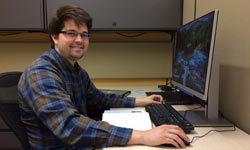
Stephen J. Murphy, Ph.D.
Postdoctoral Fellow
Center for Conservation and Sustainable Development
email:
smurphy@mobot.org
Missouri Botanical Garden
4344 Shaw Blvd.
St. Louis, MO 63110
USA
Education
Ph.D. Ohio State University, 2018
M.S. Ohio University, 2012
B.S. Denison University, 2009
I am interested in documenting variation in biological diversity and understanding why such variation exists in nature. In other words, I search for the relevant ecological and evolutionary mechanisms generating the distribution and abundance of species (mostly plants) across space and time. I work at both local and regional scales. As such, I am interested in both the macroecological processes generating broadscale diversity patterns and species pools, as well as the local species interactions driving community assembly. Together, my goal is to better understand the origin and long-term maintenance of species diversity.
Specific Interests: Species coexistence Habitat Filtering Neighborhood interactions Beta-diversity Species pools Forest ecology
For Dr. Murphy complete CV with list of publications, click
here (Adobe Acrobat Reader required).
McCall, A.C., S. Case, K. Espy, G. Adams, S.J. Murphy. 2018. Leaf herbivory induces resistance against florivores in Raphanus sativus. Botany 96: 337–343. Murphy, S.J., T. Wiegand, L.S. Comita. 2017. Distance-dependent seedling mortality and long-term spacing dynamics in a neotropical forest community. Ecology Letters 20:1469–1478. Fotis, A.T., S.J. Murphy, R.D. Ricart, M. Krishnadas, J. Whitacre, J.W. Wenzel, S.A. Queenborough, L.S. Comita. 2018. Aboveground biomass is driven by mass-ratio effects and stand structural attributes in a temperate deciduous forest. Journal of Ecology 106:561–570. Audino, L.D, S.J. Murphy, L. Zambaldi, J. Louzada, L.S. Comita. 2017. Drivers of community assembly in tropical forest restoration sites: role of local environment, landscape and space. Ecological Applications 27:1731–1745. Murphy, S.J. and B.C. McCarthy. 2017. Neighborhood interactions and local edaphic gradients have a weak influence on long-term vegetation dynamics in an old-growth forest community. Forest Ecology & Management 389:314–322. Murphy, S.J., K. Xu, L.S. Comita. 2016. Tree seedling richness, but not neighborhood composition, influences insect herbivory in a temperate deciduous forest community. Ecology and Evolution 6:1–10. Murphy, S.J., K. Salpeter, L.S. Comita. 2016. Higher ß-diversity observed for herbs over woody plants is driven by stronger habitat filtering in a tropical understory. Ecology 97:2074–2084. Murphy, S.J., L.D. Audino, J. Whitacre, J. Eck, J.W. Wenzel, S.A. Queenborough, and L.S. Comita. 2015. Species associations structured by environment and land-use history promote beta-diversity in a temperate forest. Ecology 96:705–715. Comita, L.S., S.A. Queenborough, S.J. Murphy, J. Eck, K. Xu, M. Krishnadas, N. Beckman, Y. Zhu. 2014. Testing predictions of the Janzen-Connell hypothesis: A meta-analysis of experimental evidence for distance- and density-dependent seed and seedling survival. Journal of Ecology 102:845–856. Murphy, S.J. and B.C. McCarthy. 2014. Temporal change in the herbaceous understory community of an old-growth forest: from seasons to decades. Plant Ecology 215:221–232. McCall, A.C., S.J. Murphy, C. Venner, and M. Brown. 2012. Florivores prefer white over pink petal color morphs in wild radish (Raphanus sativus). Oecologia 172:189–195. Murphy, S.J. and B.C. McCarthy. 2012. Evidence for topographic control of tree spatial patterning in an old-growth, mixed mesophytic forest in southeastern Ohio, USA. Journal of the Torrey Botanical Society 139:181–193.